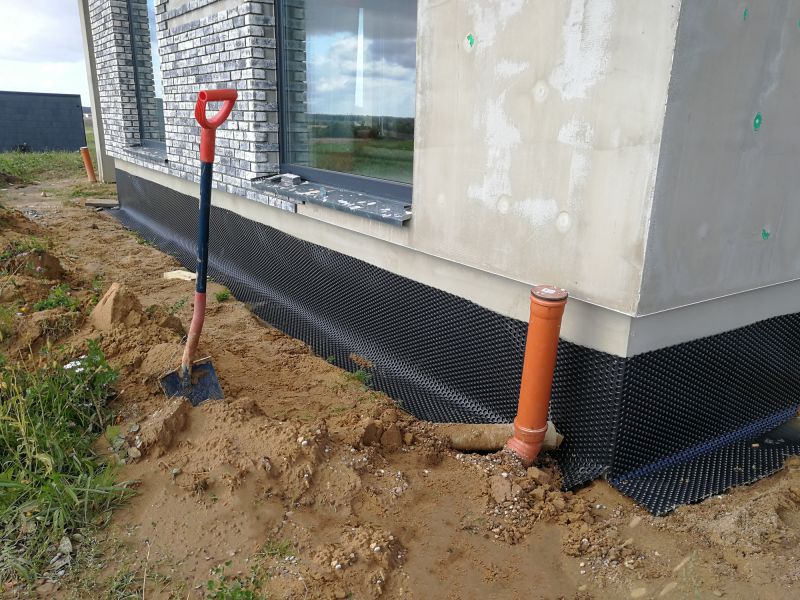Ultimate Guide To Foundation Drainage Products For Seamless Installations
Learn about key products that simplify foundation drain setup and enhance structural integrity for your property.
 Foundation drainage systems are essential components in maintaining the structural integrity of buildings by directing excess water away from the foundation. Proper installation of foundation drains can help prevent water accumulation that may lead to issues such as basement flooding, foundation cracking, or mold growth. These systems typically involve a combination of drainage pipes, gravel, and sometimes filter fabrics to ensure water flows efficiently away from the foundation walls. Selecting the right products for installation is crucial for long-term performance and minimal maintenance.
Foundation drainage systems are essential components in maintaining the structural integrity of buildings by directing excess water away from the foundation. Proper installation of foundation drains can help prevent water accumulation that may lead to issues such as basement flooding, foundation cracking, or mold growth. These systems typically involve a combination of drainage pipes, gravel, and sometimes filter fabrics to ensure water flows efficiently away from the foundation walls. Selecting the right products for installation is crucial for long-term performance and minimal maintenance.
Top Overall Option
Flexible Drainage Pipe System
A versatile and adaptable drainage pipe system designed to accommodate various installation scenarios. Its flexible construction allows for easier trenching and routing around obstacles, making it suitable for a wide range of foundation drainage projects. Paired with compatible fittings and filter fabrics, it offers a comprehensive solution for effective water management around foundations.
Types of Products For Foundation Drains Installations
Perforated Drainage Pipes
Standard pipes with perforations to facilitate water entry and exit, commonly used in trench drainage systems.
Corrugated Drain Pipes
Flexible, ribbed pipes that are easy to install and adapt to various trench shapes and sizes.
Filter Fabric Wraps
Specialized fabrics that wrap around drainage pipes to prevent soil intrusion and clogging.
Basement Drainage Channels
Pre-formed channels designed to direct water away from basement walls efficiently.
Gravel and Drain Media
Crushed stones or specialized media used to surround drainage pipes for optimal water flow.
Outlet Fittings
Connectors and fittings that direct water from drainage pipes to downspouts or sump pumps.
Sump Pump Discharge Lines
Pipes that carry water from sump pumps to exterior drainage points.
Flexible Couplings
Connectors that join different pipe sections securely while allowing some movement.
Grate Covers
Protective covers for drain outlets to prevent debris entry while allowing water flow.
Trench Drain Systems
Pre-fabricated systems designed to channel surface water away from foundations efficiently.
Waterproof Membranes
Barrier materials applied to foundation walls to prevent water infiltration.
Drainage Pumps
Submersible or pedestal pumps used to remove accumulated water from sump pits.
Erosion Control Mats
Matting materials to stabilize soil and prevent erosion around drainage trenches.
Inspection Ports
Access points for inspecting and maintaining drainage systems.
Pipe Anchors and Supports
Hardware to secure pipes in place and prevent movement or sagging.
Popular Choices
Widely used for their effectiveness in collecting and redirecting groundwater around foundations.
Favored for their flexibility and ease of installation in various trench layouts.
Commonly selected to prevent soil intrusion into drainage pipes, ensuring long-term functionality.
Popular for surface water management, especially in areas prone to pooling or runoff issues.
Frequently used to actively remove water from sump pits, especially in high water table zones.
A common choice for surrounding drainage pipes to facilitate water flow and filtration.
Increasingly popular for directing water away from basement walls and preventing seepage.
Popular for connecting pipe sections securely while allowing some flexibility during installation.
Commonly used to cover drain outlets, preventing debris entry while allowing water passage.
Frequently selected to enhance foundation wall protection against water intrusion.
When considering foundation drain products, it is important to evaluate the specific site conditions, including soil type, water table level, and the extent of drainage needed. The installation process often involves trenching around the foundation perimeter, laying drainage pipes, and covering them with gravel or other drainage media. Proper planning and product selection can simplify installation and enhance effectiveness.
Additionally, various accessories such as pipe connectors, filter fabrics, and outlet fittings are available to customize drainage systems to fit unique building requirements. Some products are designed for easy installation, featuring flexible materials or pre-assembled units, while others may require more extensive setup. Ensuring compatibility between components and adherence to local building codes is vital for a successful foundation drainage system.
Investing in quality foundation drain products can contribute to the longevity of a building’s foundation. Regular inspection and maintenance of these systems help identify potential issues early and ensure continuous water management. By choosing appropriate, durable products, property owners and contractors can create reliable drainage solutions that support the structural health of the property over time.
Key Buying Considerations
- Assess the site conditions, including soil type, water table, and drainage needs.
- Choose pipe materials that are compatible with the installation environment and long-term durability.
- Consider perforation size and pattern to optimize water entry and exit points.
- Ensure the system includes appropriate filter fabrics to prevent soil clogging.
- Evaluate ease of installation, especially if DIY setup or limited access is a factor.
- Check for compatibility of fittings, connectors, and accessories to ensure system integrity.
- Determine the necessary pipe diameter based on expected water flow volumes.
- Look for products with corrosion-resistant and UV-stable materials for outdoor use.
- Plan for proper outlet placement to direct water away from the foundation effectively.
- Consider maintenance access points such as inspection ports for long-term system health.
- Review local building codes and regulations to ensure compliance.
- Estimate the total system length and additional components needed for complete coverage.
- Assess the need for additional components like sump pumps or discharge lines based on site conditions.
- Prioritize high-quality materials to reduce potential clogging or failure over time.
- Evaluate warranty and product support options for added peace of mind.
